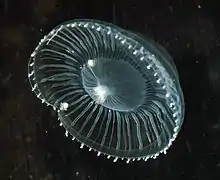Leptothecata
Leptothecata, or thecate hydroids, are an order of hydrozoans in the phylum Cnidaria. Their closest living relatives are the athecate hydroids which are similar enough to have always been considered closely related, and the very apomorphic Siphonophora which were placed outside the "Hydroida". Given that there are no firm rules for synonymy for high-ranked taxa, alternative names like Leptomedusa, Thecaphora or Thecata, with or without the ending emended to "-ae", are also often used for Leptothecata.[1]

| Thecate hydroids | |
|---|---|
 | |
| Crystal Jelly (Aequorea victoria, Conica: Aequoreidae) with the parasitic amphipod Hyperia medusarum | |
| Scientific classification | |
| Kingdom: | Animalia |
| Phylum: | Cnidaria |
| Class: | Hydrozoa |
| Subclass: | Hydroidolina |
| Order: | Leptothecata Cornelius, 1992 |
| Synonyms | |
| |
The approximately 1,900 species of Leptothecata are characterized by a number of features: Their polyps are always living in colonies with the hydranths set in hydrotheca which are usually permanent and often long enough so the animal can fully retract into it; some have very reduced hydrothecae resembling Anthoathecata. There is a single whorl of tentacles.
The gonophores are borne on much reduced hydranths and usually protected in a peridermal gonotheca. Medusae forming on fully developed hydranths are extremely rare; usually the gonophores develop into medusae or into sessile sporosacs. The medusae have a shallow bell, bear the gonads on their radial canals, and usually have statocysts which are formed only from epidermal tissue and more than four tentacles and. The cnidome never has stenoteles.
Notable species of Leptothecata include:
- Air fern (Sertularia argentea), sold dried as novelty "plants" and aquarium ornaments
- Crystal jelly (Aequorea victoria), a bioluminescent hydrozoan
- Sea fur (Obelia spp.), a common coastal polyp and medusa
Taxonomy and systematics
The thecate hydroids were formerly placed in the paraphyletic "Hydroida" as the suborder Leptomedusa. Currently, the following families are classified within the order Leptothecata:[2]
- Basal and incertae sedis Leptothecata
- Family Aequoreidae
- Family Barcinidae
- Family Blackfordiidae
- Family Bonneviellidae
- Family Campanulariidae
- Family Campanulinidae
- Family Cirrholoveniidae
- Family Clathrozoidae
- Family Dipleurosomatidae
- Family Eirenidae
- Family Haleciidae
- Family Hebellidae
- Family Lafoeidae
- Family Laodiceidae
- Family Lineolariidae
- Family Lovenellidae
- Family Malagazziidae
- Family Melicertidae
- Family Mitrocomidae
- Family Octocannoididae
- Family Orchistomatidae
- Family †Palaequoreidae
- Family Phialellidae
- Family Phialuciidae
- Family Staurothecidae
- Family Sugiuridae
- Family Symplectoscyphidae
- Family Syntheciidae
- Family Teclaiidae
- Family Tiarannidae
- Family Tiaropsidae
- Family Zygophylacidae
- Superfamily Plumularioidea
- Family Aglaopheniidae
- Family Halopterididae
- Family Kirchenpaueriidae
- Family Phylactothecidae
- Family Plumaleciidae
- Family Plumulariidae
- Family Schizotrichidae
- Superfamily Sertularioidea
- Family Sertularellidae
- Family Sertulariidae
- Family Thyroscyphidae
References
- Schuchert (2005a)
- "WoRMS - World Register of Marine Species - Leptothecata". marinespecies.org. Retrieved 2018-03-16.
- MarineSpecies.org (2008): Leptomedusae. Retrieved 2008-JUL-08.
- Schuchert, Peter (2005a): The Hydrozoa Directory - Hydrozoan Phylogeny and Classification. Retrieved 2008-JUL-08.
- Schuchert, Peter (2005b): The Hydrozoa Directory - Order Leptomedusae Haeckel, 1879. Retrieved 2008-JUL-08.